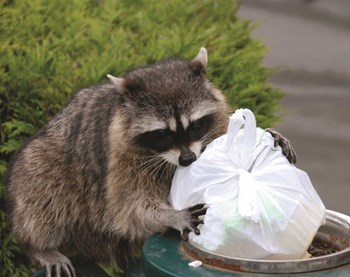
Rick Wilberschied of All That’s Wildlife in Chicago once had to catch a raccoon that had climbed 64 stories and was sitting on an apartment building balcony. Three months ago, in Chicago’s Boystown, a mother deer found an unlikely spot to give birth to two fawns—right outside an apartment building.
While these 'close encounters' were harmless, it shows that despite expanding urbanization and development, nature is never far away. But in many cases, wildlife can cause a tremendous amount of damage as they navigate their way onto properties. Migrating geese can befoul golf courses and deer can chew hedges into mulch. Bats nest in attics, causing a build up of unsanitary conditions thanks to their droppings, or guano. Gophers, raccoons, and squirrels can wreak havoc on landscaping, strew garbage for blocks, and infringe on residents’ peace and quiet.
Ryan Nicholson of Attic Solutions in Pingree Grove, says the most common wildlife complaints he gets in the Chicagoland area are for wayward raccoons and marauding squirrels. “Both varmints can chew through a roof, tear through an attic fan on the roof and pull down soffits to gain access to the attic,” says Nicholson. “Once they are in the attic, they mat down insulation [making it less efficient] and then they urinate and defecate.”
Nicholson says that squirrels often chew through soffits or roof fascia, or where the gutter protrudes from the structure. “Both squirrels and raccoons will have babies up there,” he says. “Squirrels and raccoons can also chew through wiring, but they aren’t really looking to nest.”
Wilberschied, a.k.a. “The Critter Hunter,” of television lore, adds skunks to his most ‘not wanted’ list. “Skunks get underneath existing stoops and into basements of homes,” he says. “They also knock windows open and get in that way. The worst season is when they breed in February and March. Usually by May you start getting calls from people seeing skunks digging under stoops. The females have their babies, and when the babies start to leave the den by mid-June, they're scared of everything and spray a lot. They are very trigger-happy.”
Feathered Fiends
Some pests come with feathers rather than fur. The Humane Society of the United States says that Canadian geese have also become an increasingly troublesome problem for homeowners and municipalities around the country.
“The geese problem is ridiculous everywhere,” says Wilberschied. “They used to migrate, but not now. We have factory and aerated ponds with lush grass and they love that. In downtown Chicago, they are crossing into traffic. In the suburbs, 50 of them will just wander out into a busy road.”
Geese are drawn to water, so they’ll be attracted to an association’s retention pond or lake, but the problem that residents have with geese is often aesthetic, with their droppings littering sidewalks and grass.
“If your property just has a pair of geese, that pair excretes the same waste as an adult human being in one day,” he says. “So add it up; if you have 200 to 1,000 geese at certain times of year, their excrement can ruin a lake—not to mention that it’s a health hazard if they get on baseball and soccer fields.”
To move geese off the property, people have tried fake dogs, chemical sprays and water sprinklers. They are not long term solutions, but according to the Humane Society, there are long-term humane solutions such as population stabilization, which slows down or stops the increase in the resident goose population. It uses an oiling system that stops the eggs from development. As a result, no goslings mean the parents and other members of the flock have no reason to stay. A border collie is also used because it mimics an arctic fox, a natural known predator of the geese.
A company that works with border collies must have special training to work with the dog and a special permit taken out in the name of the owner of the property if there is going to be any handling of the eggs. The Humane Society states on their website that border collies should not be used between mid-November and mid-May. It's too cold in the winter and nesting geese should not be disturbed.
Leave ‘em Alone
The mama deer in Boystown went to a secluded gravel courtyard behind an apartment building to have her fawns—her presence was surprising, but she wasn't a threat or nuisance to the property. As a general rule, it's the policy of Chicago Animal Care and Control to leave animals alone unless they are injured or pose a threat. Similarly, if an animal or bird is not causing property damage and is not a threat to public safety, the University of Illinois Extension says it is in fact illegal to remove it. If the animal is causing substantial property damage or represents a safety issue, there are courses of action that can be taken.
Whether or not a wildlife company can do anything about an animal depends on the problem, however. Two geese in a pond or a few deer loitering around on a property once or twice a week is something that residents will have to live with. Remember that the outdoors is their home.
Animals inside a building or unit are another matter. A raccoon in a building or a nest of bats in an attic can be trapped and removed. First check government listings in the telephone directory to see if your municipality or county has an animal control department that will handle wildlife control cases. The U of I Extension says that many do not have the resources to provide this service. If that's the case for your property, you can hire a nuisance wildlife control operator to trap and remove the animal.
“Once certain animals are trapped—like skunks, for example—there is a mandatory euthanasia law for them,” says Wilberschied. “The number-one reason is because of rabies, but they can carry 27 different types of diseases and parasites.”
Some animals (squirrels, for example) can be turned loose on the property once they're extracted from an attic or garage, but as a rule, an animal that has been trapped cannot just be released into a different area. “You can turn other wildlife loose on the property with permission or take the animal into a vet, if you can find a rehabilitator,” says Wilberschied.
Caring about the welfare of individual animals is understandable. However, the Illinois Department of Natural Resources (DNR) says that when an animal is relocated there is more at stake than the welfare of that particular critter.
According to the Illinois DNR website, “There are several reasons why it may be better not to relocate an animal. First, if the animal is relocated to another urban area, someone else is going to inherit your problem. Second, handling and transporting a wild animal can be dangerous. Third, any diseases or pests that the relocated animal carries have the potential to spread to the new local population which puts other animals, and potentially people, at risk. Finally, the reality is that many relocated animals do not survive. The new location to which the animal is moved will already have a population of animals using the resources (food, water, and shelter) of the area.” Animal control pros add that relocated animals are unfamiliar with the territory they find themselves in, and may be more vulnerable to predators and of being struck and killed by motor vehicles.
Do-It-Yourself?
If you want to take the chance and remove the animal yourself, the U of I Extension suggests calling your local DNR, wildlife biologist or Conservation Police Officer to request an animal removal permit. A permit will be issued only after all other reasonable control methods have failed to remedy the problem.
“If you’re not familiar with or have never handled wildlife, don’t do it,” says Wilberschied. “Every circumstance is different. Sometimes the cornered animal will come right through the drywall. That’s when I usually get a call at three in the morning and have to tell the client to seal off that room and wait till I get there.”
Certain species (house mice, for example) are not covered by the Wildlife Code, and so you do not need a permit to remove them from your property. Other species, such as those that are threatened or endangered, may not be removed.
You can also call the U.S. Department of Agriculture’s Animal Plant and Health Inspection Service (APHIS) Wildlife Services to remove the bird or animal. If you need a permit to remove a bird or nest, Wildlife Services should be called before calling Illinois’ DNR. The Wildlife Services program in Illinois helps residents resolve conflicts with wildlife that affect agriculture, human health and safety, natural resources, public infrastructure, and private property.
As for going online for advice on what to do about the bats in your belfry or the raccoons in your rec room, Nicholson says skip it. “They’ll recommend putting mothballs up there, or soaking rags in ammonia, using strobe lights or music but what I usually find is that we go there to take care of stuff and it makes it smell worse,” he says. “Most of the time when animals set up shop they are there and if you close the hole so they don’t return, most of the time it works, but if they had babies up there, they will tear holes somewhere else.”
Today, there are several advancements that help find wildlife on properties, including the use of a GPS system and trail cameras. GPS systems on traps allow the operator to get a text message/email, so the animal isn’t sitting in the heat or cold for a long period of time. Trail cameras take photos as something goes by.
Please Don’t Feed the Animals
While feeding ducks, geese, deer and other stray animals might sound like fun, residents must be made aware that it only exacerbates the problem—as do homeowners who leave a garage door open or garbage uncovered. It’s an open invitation for furry creatures to come in and forage for goodies. Keeping the garbage covered and inaccessible will help to keep all animals away.
Another way to keep animals off the property is to make landscaping changes. Plant vegetation that deer do not find tasty, or tall vegetation near water areas to keep out geese (they think their prey hides in the tall areas). Also, make sure trees and limbs are trimmed back so the animals cannot get on to the roof. (Remember the raccoon that climbed 64 stories? It got a boost from a tree near the lowest balcony.)
“It all starts with preventative maintenance,” says Nicholson. “Most of the time it’s because wood is rotting out, or the roof is old and has hole in it; the animals just walk right in. If nothing is rotted out, you’re not giving them free access to the house.”
When hiring a wildlife or pest control expert, make sure they have the right permits or licenses to do the job. They must have a nuisance wildlife control operator license and a valid nuisance wildlife control permit from the Illinois Department of Natural Resources. To obtain the license, operators must pass an annual test administered by the DNR and must follow strict guidelines for capturing, handling, and transporting animals.
It also helps if a removal expert is a member of the National Wildlife Control Operators Association. The association is organized exclusively as a mutual benefit non-profit trade association to assist people and organizations providing commercial wildlife damage management and control services. According to the NWCOA's mission statement, the association “is active in training, educating and promoting competence, service and integrity to the members of the wildlife damage management industry.”
When the experts are called, they’ll often start with questions about sound and time of day. “It gives me an idea of what the animal is and we’ll give them a price quote,” says Nicholson. “We do an inspection outside and see if they are coming in. With squirrels and bats, we’ll see what kind of damage they have done, but we’ll get the raccoons out of there before we go up there because they can attack.”
Wildlife experts can work both on annual contracts or one-time visits with the price depending on the size of the facility. If an animal is in a unit, not a common area, the responsibility may be the tenant or unit owner’s depending on the rules of the association.
Being proactive in keeping animals out of buildings and off the property by securing access, sealing up garbage and plugging holes in walls, is the first step to protecting your property from unwanted animal guests.
Lisa Iannucci is a freelance writer and a frequent contributor to The Chicagoland Cooperator.






Leave a Comment